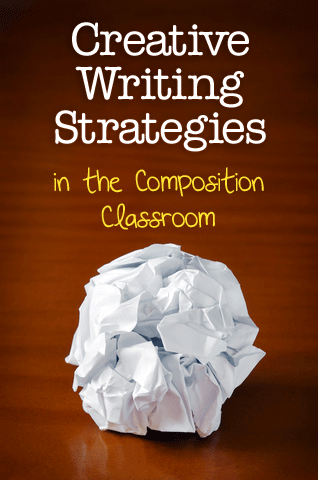Creative Writing Strategies in the Composition Classroom


Even knowing where to begin can difficult, especially when dealing with the unfamiliar. In writing, fortunately, there are some strategies that can help in the difficult “birthing” process.

Just committing time to writing the paper is the first step. Turning off the phone, shutting the door, avoiding your email box, and deciding to spend this block of time, whether it’s fifteen minutes or two hours, on your writing is the first step.
Pour out everything you know on the topic. Use abbreviations.
For example, in a recent short story, a mystery about a missing person’s investigation, I started with some dialogue, description, and some basic plot points regarding the investigation. I just threw everything I had into a word document. This same technique can also be used for essay writing--everything the writer knows or has to say on the topic should be jotted down as a beginning step. Complete sentences or even complete words are not necessary (as long as the writer can read her notes later).
While writing the short story about police investigations, I realized I knew little about how private investigators actually conduct such work. So I did some basic research on how private investigators manage a missing person’s case, took some notes, and actually learned enough to get further ideas about how to develop the story. Researching any topic for fiction or nonfiction will create additional ideas for development of the current and future project, but it’s important not to get too sidetracked into doing research, just enough to develop your work. This is a writing, not research, project.
During the course of drafting, it is important to keep up momentum. So in the places where I was not sure if a plot point, such as whether a private investigator ever works along with police on a case, I’d put a question mark at points I would look up later. Similarly, if got an idea for further developing a scene, I’d write it in the margins, and draw arrows to where it should go. I also wrote scenes as they came to me, such as the private investigator finally finding and confronting the missing person. I knew this scene would have to occur somewhere near the end, but wasn’t quite sure where, so I used numbers to put scenes in the approximate order.
Just as the writer should not get held up with research and the finer elements of organization and transitions, the first draft is not the time to get hung up running to the dictionary or thesaurus. Question marks with “sp” for possible spelling errors work fine in a first draft as no one but the writer, in most cases, will see it. So the writer should turn off, as much as possible, her internal “monitor” as well as external ones for word choice, grammar, and spelling, to revisit these issues in later drafts.
Eventually it will be time to impose some structure on your notes. It is time for an outline. An extensive outline becomes a kind of draft in itself, a blueprint of the story or essay. Cut and paste works very well here, allowing the writer to move text around, paragraphs, scenes, dialogue, description, exposition, etc., in the rough order it should occur in the work. This will then become an actual draft.
The writer now has her draft, so it is time to let it ferment. Put the draft away for a few days if possible, or don’t open its folder on the desktop, and return with fresh eyes and new ideas having let the writing percolate for a couple of days. The writer can now see the “holes” in the narrative or exposition that need to be filled in, the masterful transition needed, the need for more development, the more precise word, etc., to work on for the next draft.
Just the physical act of retyping can bring a fresh perspective, as a friend found when he failed to save his work and was forced to begin again. This unfortunate circumstance, potentially devastating to the writer, actually turned out to be advantageous as just the act of typing the work, from beginning to end, brought a more objective perspective the writer, allowing him to see where it needed further work, what parts he could cut (especially since he was retyping it), or what parts could be developed more.
A trusted friend or peer, especially if the individual is not so close to you that she worries excessively about damaging her relationship with you, can be invaluable, and even more so if she has writing experience. Where can you find such a person? A writer’s group or writing class is full of such critics, who will be supportive while still pointing out where your work needs additional polishing. Another technique, if a supportive peer is not available, is reading the work out loud, which allows the writer to hear awkwardness in phrasing, for example, or the wrong word, or unnecessary development and redundancy.
Now is the time to go back and clean up missing information, gaps in research, rename characters or vary vocabulary, clean up the spelling and grammar. Use of spell check and the thesaurus function in your word processing program can be helpful as well as the traditional paper dictionary and thesaurus. When doing the final draft, and I come across questionable spelling that is highlighted, I make a conscious effort to correct the spelling accurately myself, relying on memory and knowledge of spelling rules. If this fails, then I move to spellcheck and note the correct spelling. I am more likely to remember it as I’ve consciously studied it after attempting to correct it: for example, I now won’t forget that “accommodate” is spelled with two “c’s” and two “m’s” having gone through this process: having worked with the spelling, consciously, several times and then looked up the correct spelling and noted it, the spelling has now moved to my long-term memory, and I won’t misspell it again.
Drafting is not only a chance of to get your ideas down before rushing to the final product, but also an opportunity to learn more on a topic, do research, and develop understanding of the conventions of language.